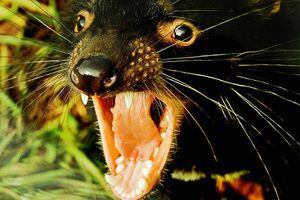TV review: Ray Mears Close Encounter: Tasmanian Devil
The nation's favourite TV wild-man is back and although he may not be eating bugs and showing us how to survive, his latest campaign to highlight the plight of rare and endangered animals is a welcome return.

I wasn't sure what to expect when I turned on Ray Mears Close Encounter: Tasmanian Devil. I must admit that I wasn't sure how the show would turn out.
Initially Mr Mears' form of adventure programming was really enjoyable when first introduced, but the format soon got boring.
However I'm glad to say that he is back and seems to have found his calling as a nature presenter.
In his latest episode he visits Tasmania, the island south of Australia made famous by the Cook expedition.
As he explains, the land once famous for its legends of howling banshees and dangerous tigers is now struggling to maintain much of its native flora and fauna.
Much of his story tells of the island's animal's plight from the now extinct Tasmanian Tiger to the critically endangered Tasmanian devil, which is suffering an epidemic from deadly facial tumour disease, a rare contagious cancer.
It's easy to see how the marsupials got their name with their growls, sharp fangs and the ability to bite through bone.
Throughout the episode Ray slowly falls in love with the animals that although cute and bear-like have a ravenous appetite.
In fact as he explores the disease that is killing of the natural population, he becomes quiet emotional at the loss of such a unique species.
Along his travels he comes across a large species of monster crayfish that can grow up to a metre long and break a man's arm.
Ray quite intelligently is wary of the creature which in previous programmes he may well have tucked into, but not this species which carries a £10,000 fine if eaten.
More interestingly he also looks at the Tasmanian Tiger which despite its name is actually a marsupial and that some believe still exists somewhere in the island's dense interior.
Officially the animal became extinct at the start of the last century when the last captive animal at Hobart Zoo died, after its ancestors had been persecuted under an official government bounty in its natural habitat.
However Ray tracks down your traditional bearded expert who believes the creature still exists following sightings and evidence of footprints and even finds a government officer who records evidence of the beast.
However my favourite animal and quite clearly a favourite of Rays, was the fascinating platypus, an animal so weird that it was once thought a fake.
Part duck and part beaver the platypus is the only poisonous mammal and lays eggs.
In fact much of what this programme shows is the impact of mankind not only on the island but its ecology and animals as well as Tasmania's aboriginal peoples.
I was surprised at how much I enjoyed the show which managed to balance information and expertise with a real sense of adventure. This two-part series was definitely a welcome return for the survival expert who I hope makes more shows looking into the world's rare and diminishing species.
Tom Mason





